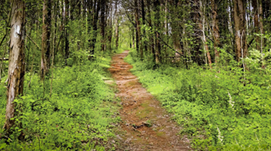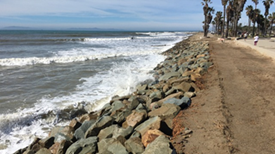Easements

What is a DNR DMLW Easement?
An easement creates a right to use land owned by another party for a specific and limited purpose without granting the rights associated with land ownership. On state lands, easements are typically linear, revocable for cause, and may be issued to state, federal, municipal, or tribal governments, and public or private persons or entities. The Division of Mining, Land and Water's (DMLW) Regional Land Offices determine if it is appropriate to authorize easements on state owned land.
When do you need an easement?
An easement is required when there is a long term need to use, access, or cross state land, including for installation of infrastructure.
Uses of State easements
Easements are commonly authorized for: access, utilities (including pipelines), and erosion/water control systems. Commonly allowable uses include:
- Power lines or fiber optic cables
- Access to private lots
- Roads and highways
- Water and sewer lines
- Seafood outfalls
- Erosion control revetments
- Drainage ditches and dikes
- Culverts



Types of Easement Authorizations
There are three types of easement authorizations: public, private, and development within an existing easement.
Public
Easements that generally serve a public purpose, such as public access across state lands, or for utilities such as water, sewer, electrical, and telecommunication. While public easements may be held by a specific entity, they typically confer the right to conduct some activity to more than one qualifying party. For example, a member of the public may use a public access easement held by the Fairbanks North Star Borough.
Private
Grants a privately held easement to an individual or business. However, the grantee may be asked to accommodate other uses that do not conflict with the grantee's intended use. For example, a seafood processing company would be granted a private outfall easement for their use only.
Development/Maintenance
This authorization allows a third party to develop or maintain infrastructure in a pre-existing easement. Some easements exist but either have not been developed, have only partially been developed, or have not been developed to meet the proposed use. These typically include:
- Section Line Easements, where they have been asserted.
- Easements reserved under Revised Statute 2477.
- Easements created by a plat but not transferred to the local platting authority.
- Easements reserved by a conveyance document.
- Platted easements in the Unorganized Borough.
- Easements granted to DMLW.
Easement Widths
Different land uses will require easements of different widths. Typically, utility easements are 30 feet in width and roads are between 60 and 100 feet in width. Easement widths will be adjusted to include all installed infrastructure, land uses, and the conditions under which the infrastructure is to be installed.
Other Easement Requests
As part of their easement management function, the Regional Land Offices consider requests to close, restrict, and/or relocate easements, as well as address the obstruction of public easements, and the amendment or assignment of existing easements.
Closure or Restriction
Interested parties may request that an easement be temporary closed. Typically, easements are closed to protect public safety but there are other conditions under which an easement can be closed such as to protect a natural resource. It is possible to restrict easements to specific uses such as pedestrian only use.
Amendment
A grantee can request a change to an easement's development plan or dimensions by contacting the DMLW Easement Unit. For example, a grantee can request to expand their commercial dock from 120 to 150 feet long.
Assignment
A grantee can transfer an easement to a third party, with approval from the DMLW Easement Unit. For example, the owner of a seafood processing plant has a private easement for a processing waste outfall line. The owner sells the plant to a new owner. The new owner must apply for the private easement to be transferred.
Vacation of platted easements
Platted easements can be vacated. For more information, please contact the DMLW Survey Section.
Privately granted easements
Individuals may grant public easements across their own land to the State to be held in trust by DMLW on behalf of the public. For more information on donating a public easement, please contact the DMLW Realty Services Section.
How to apply for an easement
1 Complete and sign the following forms
2 Complete a development plan outlining
- Infrastructure to be installed,
- Construction methods,
- Reason for requesting an easement, and
- Development diagram, including maps. This map should show what the easement connects to and where.
3 Provide copies, if available
- Maps that depict the proposed easement and the surrounding area,
- Plats of the parcel or subdivision,
- Title documents, and
- Survey/engineering information.
4 Application Fee
- Director's Fee Order PDF
- 11 AAC 05.070(d)(1) outlines the various application fees, please contact the staff in your local Regional Lands Office to determine the appropriate fee to be submitted.
5 Submit your application
Send the application forms, development plans, supporting materials, and application fee to the DMLW Easement Unit. If you have questions while completing these forms or regarding any of the information above, please contact the DMLW Easement Unit.
Easement Timeline and Process
Target timelines are for planning purposes only and are subject to change. Timelines are typically extended for projects with the potential for significant public interest or for large projects. Timelines are also impacted by ongoing workload. For a more targeted projection assessment, please contact Regional staff with your detailed project description and timing.
Target Timelines:
- Public and agency notice: 2 months after receiving a complete application.
- Decision Issuance: 8 months after receiving a complete application.
Upon determining that an application is complete, the general easement process is as follows:
1 Public & Agency Notice
Members of the public and government agencies will have the opportunity to comment on the requested easement. The DMLW Easement Unit will draft and distribute a public and agency notice for comment. Comments must typically be submitted within 30 days of the public notice being issued.
2 Regional Manager's Decision
This document describes why authorizing the request is or is not in the State's interest. It details any changes that are required and why, as well as additional requirements before the easement is issued. The application may be denied if it is determined that the proposed activity is not in the State's interest.
3 Appeal/Reconsideration Period
Notice of the Regional Manager's Decision is distributed to commenters and posted to the Alaska Online Public Notice System. There is an appeal period and an opportunity for the Commissioner to reconsider the decision. The Regional Manager's Decision does not become effective until the appeal and reconsideration period has closed and any appeals are resolved. View Appeal Regulations.
4 Insurance
The applicant may be required to submit proof of insurance before an authorization is issued. Any specific requirements will be outlined in the Regional Manager's Decision.
5 Bonding
The applicant may be required to submit a performance guaranty (bond) before an authorization is issued. Any specific requirements will be outlined in the Regional Manager's Decision.
6 Entry Authorization
If required, an Entry Authorization establishes a time frame in which the easement will be constructed and surveyed, prior to final easement issuance.
7 As-built Survey
The applicant may be required to submit a state-approved survey before the easement can be issued. The applicant is solely responsible for the cost associated with the survey.
8 Fees
The applicant must pay any required fees, including one-time land use fees, annual rental fees, recording fees, and other fees. Easement fees are established in regulation under 11 AAC 05.070(d)(2). The annual land use fee for certain easements is determined via an appraisal, which evaluates the fair market value of the land. DMLW staff will work with you if your authorization requires an appraisal.
9 Issuance
Once the applicant has met all of the required conditions, DMLW will issue and record the easement.
